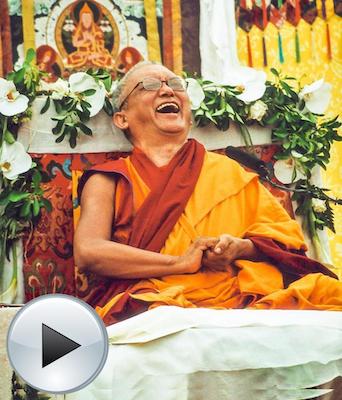In this teaching extract, Lama Zopa Rinpoche explains the benefits of making offerings to holy objects. He tells the story of a woman sprinkling sandalwood powder on the Buddha’s feet. The Buddha then told a bodhisattva that this woman would not be born in the lower realms for millions of eons. Likewise a small offering to the Buddha will cause us to be born as a deva and eventually will allow us to reach nirvana and finally full enlightenment. And this functions even without bodhicitta or even Dharma motivation, due to the power of the object. For this reason Rinpoche recommends having many holy objects in and around our house.
Read the first part of the video transcript, lightly edited by Sandra Smith, below.
The Importance of Offering to Holy Objects
I would like to do the bath offering like the Lama Gyupas, the tantric college monks. When they do pujas, when they do offerings, three people stand up while the umdze and people chant, and they do the bath offerings. Also in Thamo [Nunnery], down below Lawudo, the chanting is by the nuns. Shelkar Monastery [in Tibet] is the main source, but I’m not sure. They do the bath offering not by sitting; three nuns stand up. One nun holds the main container and then the other nun does the cleaning, wiping, offering the water on the holy body, offering the dress, then this nun holds the mirror and does this, offers water. That is a very nice way to do it, so we should do it like that.
We should do that, we should learn, we should do it correctly, we should do that, because what we do now is an example for the future. What we do now, whatever we practice, becomes the example, and it should be a good example for the future, for the continuation of the FPMT centers. We sponsor the Mani [retreat] in many places, and also the nuns in Tibet, near Solu Khumbu, that I mentioned, every year they do two Mani retreats. Then in Mongolia I think this year is the fourth or fifth one. We started at Idgaa Choizinling monastery, which we built. In Mongolia now they are very familiar with Lama Chöpa and chanting sadhanas and all that, so it is very good, they became very familiar. So now I want to start [the Mani retreat] in Russia. The Tilopa lama, the incarnation [Telo Tulku Rinpoche], many people came to his monastery in Kalmykia. Many people from Russia and Kalmykia came there, so in Kalmykia I thought to start [the Mani retreat with recitation of] one hundred million mantras. There was another lady who wrote down everything that is needed, including a bathroom. I’m joking.
What is needed is a big thangka of Thousand-arm Chenrezig. This is my thangka that I always carry, blessed by His Holiness, with His Holiness’ fingerprint on the back side. It is done by a very good artist of the previous Panchen Rinpoche, [and has a] huge holy body. In Tibet, after the destruction in Mao Zedong’s time, everything was destroyed—people had to throw everything in the river or bury it—then when Panchen Rinpoche came from China, he had an artist who did extremely well, for example, Lama Tsongkhapa and his two disciples, which was done according to meditation. Most artists don't do that because they don't know the meditation. For example, Khedrub-je is kind of wrathful, and for anybody of Lama Tsongkhapa tradition he immediately dispels obstacles, wrong concepts, so he has a wrathful aspect. Gyaltsab-je has a very subdued manner. There is also a meditation like this, and the artist knows the meditation. He does not know exactly the position, most artists don't know the meditation. The artist who painted this Chenrezig is a student of the Panchen Rinpoche’s artist, for the Kagyu, Gelug, Sakya, the great lamas. Not so much Yamantaka, Heruka, Kalachakra, not so much those deities, but the general ones, he did [thangkas] all over Tibet for people to have a holy object to pray and collect merit, and to create the cause of enlightenment. So he did my thangka. That was many years ago, so many years ago, so many years ago. Then when he finished it, he brought it up to me....
This teaching continues in the video. Click here to watch the video and read along with the transcript overlay, or alternatively, you can watch the video without the transcript. To browse more video extracts from the series, visit Lama Zopa Rinpoche Essential Extracts webpage.































